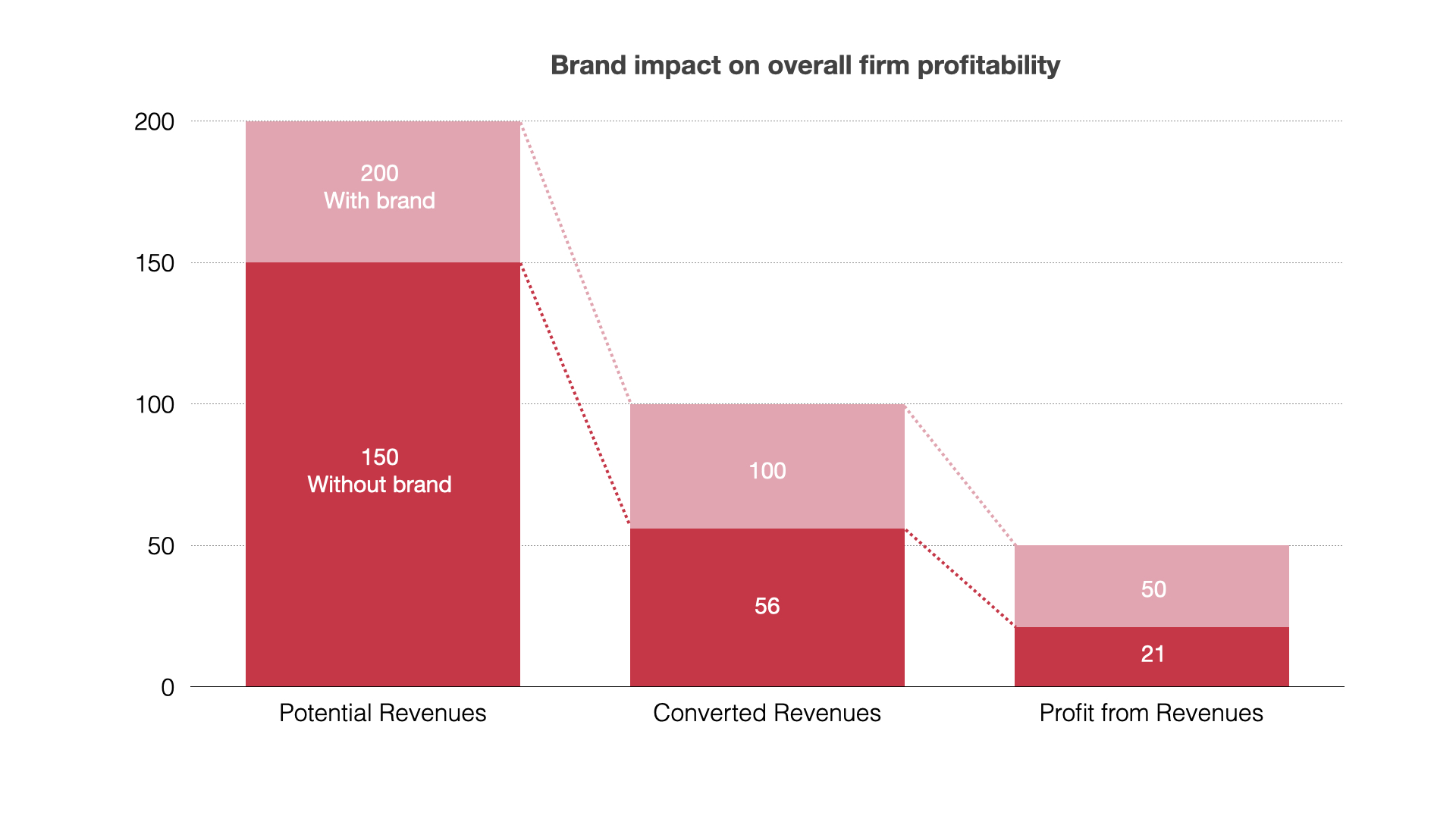Brand: The Key to 50%+ Profitability
The brand of a premium professional services firm delivers more than 50% of the firm’s profitability. Manage it carefully.
I’ve written a lot in other articles about ‘how’ to enhance a firm’s brand (click here to browse a few topics). So, in this article, I’m going to focus on the ‘why.’ Why is it important to take a strategic and leadership-led approach to managing your firm’s brand in the market? The top line is because brand drives at least 50% of a successful professional service firm’s profitability.
If it’s so important why doesn’t brand get more attention in the strategy?
Supply and demand
Most premium professional service firms have quite sophisticated business strategies these days. However, these strategies tend to be heavily weighted toward supply-side factors: resources, capabilities, locations, structures, and technologies.
In my experience, strategies tend to be relatively light when it comes to the demand-side factors: things like market positioning, reputation, value propositions, client experience, and thought leadership.
This is surprising because these things collectively add up to a firm’s brand, and a simple and conservative analysis shows that more than 50% of a large firm’s overall profitability is driven by its brand. That’s a bold claim for something as seemingly intangible as a brand but one that holds up to scrutiny as I’ll show in a moment.
By brand, I obviously don’t mean the logo.
If it’s so important why doesn’t brand get more attention in the strategy? Possibly because it’s less tangible, probably because management consultants don’t understand it, and certainly because it’s hard to change. But with such multiples on offer, it’s got to be worth giving it more attention.
By brand, I don’t mean the logo. By brand, I mean the firm’s reputation in the market as a whole and within that its reputation among multiple specialist sectors and groups of client stakeholders:
- What it’s perceived to stand for.
- What it’s known to be best at.
- Why it’s better than its rivals for solving particular problems.
Brand drives at least 50% of a successful professional service firm’s profitability.
Do the math/s
How do you get to a figure of 50%?
The answer is to assume that at three critical stages of the BD funnel – creating demand in the market, converting that demand into revenues, and pricing that revenue to produce profits – the brand adds something like 25% to what the firm’s partners could achieve if all else were equal, except that they were operating from a firm with no market reputation (or, let’s more reasonably say, from a firm that the clients didn’t know much or anything about).
#1 Awareness
So, assumption #1 is that the firm’s reputation in the market is responsible for around 25% of the potential revenues that the firm comes across in a year – i.e. 25% of the high-quality RFPs, pitches, and tenders that clients send its way. Seems reasonable, doesn’t it?
#2 Conversion
Assumption #2 is that the firm’s brand reputation drives 25% of the conversion of these leads. In other words, the brand influences decisions to go with a particular firm rather than another in 25% of cases. Again, reasonable I think.
#3 Pricing
Assumption #3 is that the firm’s brand reputation enables fee rates to be 25% higher than the partners leading the relationship might otherwise be able to achieve acting from another firm unknown to the clients. Another reasonable assumption.
A brand’s image and perceptions drive leads; its value proposition drives conversions; its reputation for delivery and impact drives pricing power.
25 becomes 50
So, if you agree that 25% is a reasonable – even conservative – level of contribution for the brand at each of these 3 steps of the BD funnel, the table below shows that collectively the overall impact on profits is at least 50%.
This is a thought experiment, of course. I can’t conceive of a real-life simulation where researchers could take a bunch of partners out of their firm for a while, but if you have trouble relating this to your firm and its brand, try it out with a McKinsey, a PWC, a Kirkland, or an Arup. Could their brands be driving 25% of their leads, conversions, and pricing power? It feels pretty easy to agree they could.
These firms are iconic in their sectors and so I would argue that their brands drive an even higher percentage of their profits. This analysis applies to averagely successful firms – those in the middle of the pack – so is much more relatable.
Where to start
If this strategic asset called the brand, is driving more than 50% of a firm’s profitability, what level of focus should there be among the firm’s leadership team in maintaining, nurturing and even growing it?
The math/s also provides an excellent structure for breaking down the components of the brand. A brand’s image and perceptions drive leads; its value proposition drives conversions; its reputation for delivery and impact drives pricing power.
So, as your firm’s CMO, next time you’re in a leadership conversation that’s premised by “we’ve got a lot on, why should we be focusing bandwidth on our brand?” mention the 50%.



